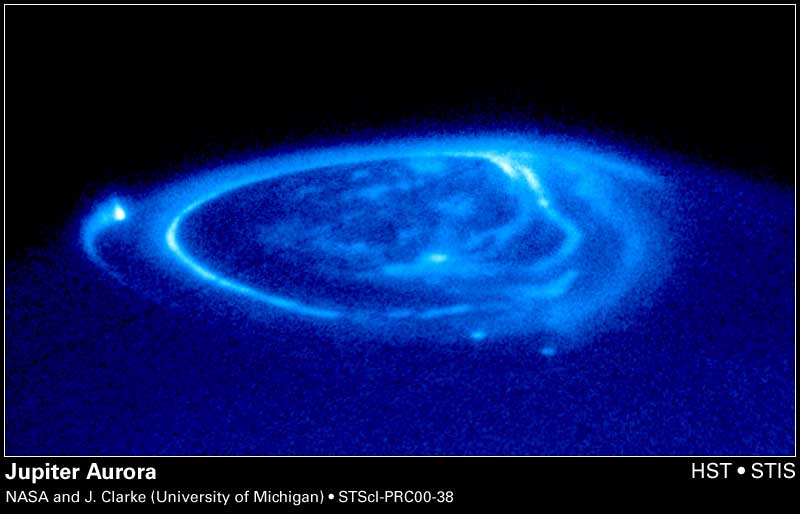A Birkeland current usually refers to the electric currents in a planet’s ionosphere that follows magnetic field lines (ie field-aligned currents), and sometimes used to described any field-aligned electric current in a space plasma.[3] They are caused by the movement of a plasma perpendicular to a magnetic field. Birkeland currents often show filamentary, or twisted “rope-like” magnetic structure. They are also known as field-aligned currents, magnetic ropes and magnetic cables).
Originally Birkeland currents referred to electric currents that contribute to the aurora, caused by the interaction of the plasma in the Solar Wind with the Earth’s magnetosphere. The current flows earthwards down the morning side of the Earth’s ionosphere, around the polar regions, and spacewards up the evening side of the ionosphere. These Birkeland currents are now sometimes called auroral electrojets. The currents were predicted in 1903 by Norwegian explorer and physicist Kristian Birkeland, who undertook expeditions into the Arctic Circle to study the aurora.
Professor Emeritus of the Alfvén Laboratory in Sweden, Carl-Gunne Fälthammar wrote (1986): “A reason why Birkeland currents are particularly interesting is that, in the plasma forced to carry them, they cause a number of plasma physical processes to occur (waves, instabilities, fine structure formation). These in turn lead to consequences such as acceleration of charged particles, both positive and negative, and element separation (such as preferential ejection of oxygen ions). Both of these classes of phenomena should have a general astrophysical interest far beyond that of understanding the space environment of our own Earth.”
Contents
Characteristics
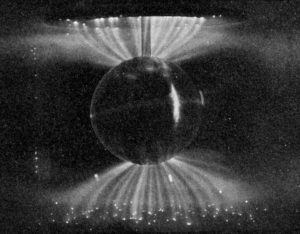
Auroral Birkeland currents can carry about 1 million amperes.[4] They can heat up the upper atmosphere which results in increased drag on low-altitude satellites.
- “Voyager 2 also detected auroras similar to those on Earth, but Neptune’s registered 50 million watts, compared to Earth’s 100 billion watts and occurred over wide regions of the planet’s surface.”[5]
Birkeland currents can also be created in the laboratory with multi-terawatt pulsed power generators. The resulting cross-section pattern indicates a hollow beam of electron in the form of a circle of vortices, a formation called the diocotron instability[6] [7] (similar, but different to the Kelvin-Helmholtz instability), that subsequently leads to filamentation. Such vortices can be seen in aurora as “auroral curls”.[8]
Birkeland currents are also one of a class of plasma phenonena called a z-pinch, so named because the azimuthal magnetic fields produced by the current pinches the current into a filamentary cable. This can also twist, producing a helical pinch that spirals like a twisted or braided rope, and this most closely corresponds to a Birkeland current. Pairs of parallel Birkeland currents can also interact; parallel Birkeland currents moving in the same direction will attract with an electromagnetic force inversely proportional to their distance apart (Note that the electromagnetic force between the individual particles is inversely proportional to the square of the distance, just like the gravitational force); parallel Birkeland currents moving in opposite directions will repel with an electromagnetic force inversely proportional to their distance apart. There is also a short-range circular component to the force between two Birkeland currents that is opposite to the longer-range parallel forces.[9]
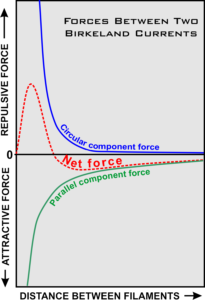
Electrons moving along a Birkeland current may be accelerated by a plasma double layer. If the resulting electrons approach relativistic velocities (ie. the speed of light) they may subsequently produce a Bennett pinch, which in a magnetic field will spiral and emit synchrotron radiation that includes radio, optical (ie. light), x-rays, and gamma rays.
In 2007, the Themis satellite “found evidence of magnetic ropes connecting Earth’s upper atmosphere directly to the sun”.[10] apparently consistent with Kristian Birkeland‘s theory of the aurora, “that a current of electric corpuscles from the sun would give rise to precipitation upon the earth” (See preface to The Norwegian Aurora Polaris Expedition 1902-1903).
Describing plasma cables, Hannes Alfvén wrote:
- “Plasma cables seem to be reasonably stable formations which can be considered as structures important for the understanding of plasma phenomena. (Of course, their interior structure should be described by classical theory.) The plasma cables are either filaments or ‘flattened filaments’ (sheets with limited extent). They carry an electric current parallel to the magnetic field, and this is what gives them their properties. The cables are often very efficient in transferring electromagnetic power from one region to another. They are embedded in passive plasmas, which have essentially the same properties in all directions around the cables. They are ‘insulated’ from their surroundings by a thin cylindrical electrostatic sheath (or double layer) which reduces the interaction with its exterior. In the magnetosphere and upper ionosphere, the density in the cable is sometimes lower than the surrounding passive plasma (Block and Fälthammar, 1968)[11]. In other cases, the density in the cable may be much larger than the surroundings because ionized matter is pumped into the cable from the outside. By selectively doing so, the chemical composition in the cable may differ from that of its exterior (Marklund, 1978, 1979)[12] (see Marklund convection). Besides the cylindrical electrostatic sheath, there are often longitudinal double layers, in which a considerable part of the power which the cable transmits may be converted into high energy particles. The double layers sometimes explode, and this produces excessively high energy particles.” [13]
Cosmic Birkeland currents
Plasma physicists suggest that many structures in the universe exhibiting filamentation are due to Birkeland currents. Peratt notes that “Regardless of scale, the motion of charged particles produces a self-magnetic field that can act on other collections of charged particles, internally or externally.[15] Plasmas in relative motion are coupled via currents that they drive though each other“. (See Plasma scaling). Examples include:
| Size | Current | Description |
|---|---|---|
| 20 × 103 m | Venus Flux ropes | |
| Cometary tails | ||
| 102–105 m | 106 A | Earth’s Aurora |
| 108 m | 105–106 A | Magnetosphere inverted V events |
| 107–108 m | 1011 A | Sun’s prominences (spicules, coronal streamers) |
| Interstellar structures: various nebulae | ||
| 1018 m | Galactic center | |
| 6 × 1020 m | Double radio galaxies: bright lobes |
Source: Peratt (1992).
History
the currents there are imagined as having come into existence mainly as a secondary effect of the electric corpuscles from the sun drawn in out of space, and thus far come under the second of the possibilities mentioned above. Fig. 50a represents those in which the current-directions at the storm-centre are directed westwards, and 50b those in which the currents move eastwards.”[16]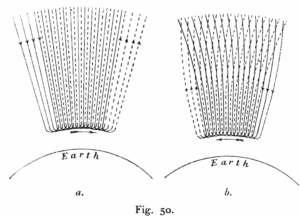
The history of Birekland Currents appears to mired in politics.[17]
After Kristian Birkeland suggested “currents there are imagined as having come into existence mainly as a secondary effect of the electric corpuscles from the sun drawn in out of space,” (1908), his ideas were generally ignored in favour of an alternative theory from British mathematician Sydney Chapman.
In 1939, the Swedish Engineer and plasma physicist Hannes Alfvén promoted Birkeland’s ideas in a paper published on the generation of the current from the Solar Wind.[18] One of Alfvén’s colleagues, Rolf Boström, also used field-aligned currents in a new model of auroral electrojets (1964).[19]
In 1966 Alfred Zmuda, J.H. Martin, and F.T.Heuring reported their findings of magnetic disturbance in the aurora, using a satellite magnetometer, but did not mention Alfvén, Birkeland, or field-aligned currents, even after it was brought to their attention by editor of the space physics section of the journal, Alex Dressler.[20]
In 1967 Alex Dessler and one of his graduates students, David Cummings, wrote an article arguing that Zmuda et al had indeed detected field align-currents.[21] Even Alfvén subsequently credited (1986) that Dessler “discovered the currents that Birkeland had predicted” and should be called Birkeland-Dessler currents.[22]
In 1969 Milo Schield, Alex Dessler and John Freeman, used the name “Birkeland currents” for the first time.[23] In 1970, Zmuda, Armstrong and Heuring wrote another paper agreeing that their observations were compatible with field-aligned currents as suggested by Cummings and Dessler, and by Bostrom, but again made no mention of Alfvén and Birkeland.[24]
In 1970, a group from Rice University also suggested that the results of an earlier rocket experiment was consistent with field-aligned currents, and credited the idea to Boström, and Dessler and his colleagues, rather than Alfvén and Birkeland.[25] In the same year, Zmudu and Amstrong did credit Alfvén and Birkeland, but felt that they “…cannot definitely identify the particles constituting the field-aligned currents.”[26]
It wasn’t until 1973 that the navy satellite Triad, carrying equipment from Zmuda and James Armstrong, detected the magnetic signatures of two large sheets of electric current. Their papers (1973, 1974) reported “more conclusive evidence” of field-aligned currents, citing Cummings and Dessler but not mentioning Birkeland or Alfven.[27]
It had taken 65 years to confirm Birkeland’s original predictions.
See also
References
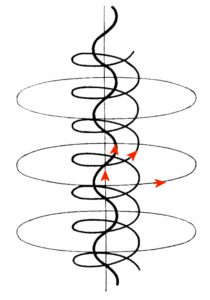
- ↑ Astronomy Picture of the Day, [1] 20 Dec 2000
- ↑ “Dessler, A. J., “Corotating Birkeland currents in Jupiter’s magnetosphere – an Io plasma-torus source“, Planetary and Space Science, vol. 28, July 1980, p. 781-788. PEER REVIEWED
- ↑ A. L. Peratt, et al, “3-dimensional Particle-in-cell Simulations Of Spiral Galaxies” FULL TEXT in Galactic and intergalactic magnetic fields; Proceedings of the 140th Symposium of IAU, June 19-23, 1989. See “3.1 Galactic dimensioned Birkeland currents”
- ↑ Fälthammar, Carl-Gunne, “Magnetospheric plasma interactions”, Astrophysics and Space Science (ISSN 0004-640X), vol. 214, nos. 1-2, Proceedings of the second United Nations/European Space Agency Workshop, Bogota, Colombia, 9-13 November, 1992, UN/ESA Workshops Vol. 3, p. 3-17. PEER REVIEWED
- ↑ “Solar Wind, Genesis, and the Planets: Do other solar system planets have protective magnetospheres?” June 23, 2008 at the NASA Jet Propulsion Laboratory Web site.
- ↑ Plasma Phenomena, Department of Physics, Czech Technical University
- ↑ Peratt, A. L.; Snell, C. M., “Microwave generation from filamentation and vortex formation within magnetically confined electron beams“, Physical Review Letters (ISSN 0031-9007), vol. 54, March 18, 1985, p. 1167-1170. Research supported by the U.S. Department of Energy. PaperFULL TEXT PDF PEER REVIEWED
- ↑ Auroral Curls, University of Calgary Portable Auroral Imager
- ↑ Peratt, Anthony L., “The evidence for electrical currents in cosmic plasma“, IEEE Transactions on Plasma Science (ISSN 0093-3813), vol. 18, Feb. 1990, p. 26-32. Paper FULL TEXT PDF PEER REVIEWED
- ↑ “NASA Spacecraft Make New Discoveries About Northern Lights” FULL TEXT NASA Themis press release, 11 Dec 2007
- ↑ Block, L.P., Fälthammar, C.-G, “Effects of field-aligned currents on the structure of the ionosphere (Magnetic field aligned electric currents effects on ionospheric structure, noting electron concentration variations and plasma diffusion)” (1968) J. Geophys. Res., 73: 4807-12 (Aug. 1, 1968). PEER REVIEWED
- ↑ Marklund, G. T., “Plasma convection in force-free magnetic fields as a mechanism for chemical separation in cosmical plasma“, Nature, vol. 277, Feb. 1, 1979, p. 370, 371 PEER REVIEWED. See also “Steady State Models for Filamentary Plasma Structures Associated with Force Free Magnetic Fields (1978) Royal Institute of Technology, Stockholm (TRITA-EPP-78-09) ISSN: 0348-7539
- ↑ Hannes Alfvén, Cosmic Plasma (1981). Astrophysics and Space Science Library, Vol. 82 (1981) Springer Verlag. ISBN 90-277-1151-8.
- ↑ Peratt, A. L.; Peter, W.; Snell, C. M., “3-dimensional particle-in-cell simulations of spiral galaxies“, Galactic and intergalactic magnetic fields; Proceedings of the 140th Symposium of IAU, Heidelberg, Federal Republic of Germany, June 19-23, 1989 (A91-46626 20-90). Dordrecht, Netherlands, Kluwer Academic Publishers, 1990, p. 143-148; Discussion, p. 149, 150. PEER REVIEWED
- ↑ Peratt, Anthony, Physics of the Plasma Universe, “Birkeland Currents in Cosmic Plasma” (p.43-92)
- ↑ Kristian Birkeland, The Norwegian Aurora Polaris Expedition 1902-1903, Volume 1: On the Cause of Magnetic Storms and The Origin of Terrestrial Magnetism. Section 1 published 1908; Section 3 publ. 1913
- ↑ Brush, Stephen G., “Alfven’s programme in solar system physics“, IEEE Transactions on Plasma Science (ISSN 0093-3813), vol. 20, no. 6, p. 577-589. PEER REVIEWED
- ↑ Alfvén, Hannes, “Theory of Magnetic Storms and of the Aurorae”, K. Sven. Vetenskapsakad. Handl., ser. 3, vol. 18, no. 3, p. 1, 1939. Reprinted in part, with comments by A. J. Dessler and J. Wilcox, in Eos, Trans. Am. Geophys. Un., vol. 51, p. 180, 1970.
- ↑ * Bostrom, R., “A model of the auroral electrojets,” J. Geophys. Res., vol. 69, p. 4983, 1964. PEER REVIEWED
- ↑ Zmuda, A. J.; Martin, J. H.; Heuring, F. T. “Transverse magnetic disturbances at 1100 kilometers in the auroral region,” J . Geophys. Res., vol. 71, p. 5033, 1966. PEER REVIEWED
- ↑ Cummings, W. D.; Dessler, A. J.; “Field-aligned currents in the magnetosphere,” J. Geophys. Res., vol. 72, p. 1007, 1967. PEER REVIEWED
- ↑ Alfvén, Hannes, “Double layers and circuits in astrophysics,” IEEE Trans. Plasma Sci., vol. 14, p. 779, 1986 (on p. 787). PEER REVIEWED. Reproduced from “Keynote Address” in Double Layers in Astrophysics, Proceedings of a Workshop held in Huntsville, Ala., 17-19 Mar. 1986. Proceedings FULL TEXT PDF (page 12)
- ↑ * Schield, M. A.; Freeman, J. W.; Dessler, A. J., (1969) “A Source for Field-Aligned Currents at Auroral Latitudes“, Journal of Geophysical Research, Vol. 74, p.247. PEER REVIEWED
- ↑ Zmuda, A. J.; Armstrong, J. C.; Heuring, F. T. “Characteristics of transverse magnetic disturbances observed at 1100 km in the auroral oval“, J. Geophys. Res., vol. 75, p. 4757, 1970. PEER REVIEWED
- ↑ P. A. Cloutier, H. R. Anderson, R. J. Park, R. R. Vondrak, R. J.
Spiger and B. R. Sandel, “Detection of geomagnetically aligned currents associated with an auroral arc“, J. Geophys. Res., vol. 75, p. 2595, 1970. PEER REVIEWED - ↑ Armstrong J. C.; Zmuda, A. J.; “Field-aligned current at 1100km in the auroral region measured by satellite,” J. Geophys. Res., vol. 75, p. 7122, 1970. PEER REVIEWED
- ↑ Armstrong J. C.; Zmuda, A. J.; “Triaxial magnetic measurements of field-aligned currents at 800 kilometers in the auroral region: Initial results,” J. Geophys. Res., vol. 78, p. 6802, 1973. PEER REVIEWED; Zmuda A. J.; Armstrong J. C.; “The diurnal flow pattern of field-aligned currents,” J. Geophys. Res., vol. 79, p. 4611, 1974. PEER REVIEWED
- ↑ Hannes Alfvén and Gustaf Arrhenius, Evolution of the Solar System, NASA Publication SP-345, (1976)
References
(Peer-reviewed online in full)
- Potemra, T. A. “Birkeland currents in the earth’s magnetosphere“FULL TEXT, from a Special Issue of Astrophysics and Space Science“FULL TEXT Dedicated to Hannes Alfvén on 80th Birthday. PEER REVIEWED
- Alfvén, Hannes, On the Filamentary Structure of the Solar Corona FULL TEXT (1963), The Solar Corona; Proceedings of IAU Symposium no. 16 held at Cloudcroft, New Mexico, U.S.A. 28-30 August, 1961.
- Alfvén, Hannes, Currents in the Solar Atmosphere and a Theory of Solar Flares FULL TEXT (1967) Solar Physics, Vol. 1, p.220, PEER REVIEWED
- Alfvén, Hannes, On the Importance of Electric Fields in the Magnetosphere and Interplanetary Space FULL TEXT (1967) Space Science Reviews, vol. 7, p.140, PEER REVIEWED
- Carlqvist, P., Cosmic electric currents and the generalized Bennett relation,FULL TEXT Astrophysics and Space Science (ISSN 0004-640X), vol. 144, no. 1-2, May 1988, p. 73-84. (1988) PEER REVIEWED
- Cloutier, P. A.; Anderson, H. R. Observations of Birkeland currents FULL TEXT (1975), Space Science Reviews, vol. 17, Mar.-June 1975, p. 563-587, PEER REVIEWED
- Peter, William; Peratt, Anthony L., “Thermalization of synchrotron radiation from field-aligned currents“,FULL TEXT Laser and Particle Beams (ISSN 0263-0346), vol. 6, Aug. 1988, p. 493-501. PEER REVIEWED
- Peratt, A. L., “Plasma and the Universe: Large Scale Dynamics, Filamentation, and Radiation“,FULL TEXT Astrophysics and Space Science, v. 227, p. 97-107, PEER REVIEWED
- Peratt, A. L., “Electric space: evolution of the plasma universe“,FULL TEXT Astrophysics & Space Science, 244, 89-103 (1996) PEER REVIEWED
- Potemra, T. A. Observation of Birkeland currents with the TRIAD satellite FULL TEXT (1978) Astrophysics and Space Science, vol. 58, no. 1, Sept. 1978, p. 207-226. PEER REVIEWED
